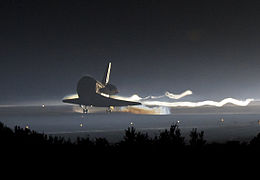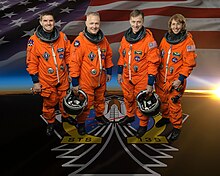
Back STS-135 Arabic STS-135 Bulgarian STS-135 Catalan STS-135 Czech STS-135 Danish STS-135 German STS-135 Spanish STS-135 Estonian استیاس-۱۳۵ Persian STS-135 Finnish
 Atlantis lands at the Kennedy Space Center on July 21, 2011, bringing the Shuttle program to an end. | |
| Names | Space Transportation System-135 |
|---|---|
| Mission type | ISS logistics |
| Operator | NASA |
| COSPAR ID | 2011-031A |
| SATCAT no. | 37736 |
| Mission duration | 12 days, 18 hours, 28 minutes, 50 seconds |
| Distance travelled | 8,505,161 km (5,284,862 mi) |
| Spacecraft properties | |
| Spacecraft | Space Shuttle Atlantis |
| Launch mass |
|
| Landing mass | 102,682 kg (226,375 lb) |
| Payload mass | 12,890 kg (28,418 lb) |
| Crew | |
| Crew size | 4 |
| Members | |
| Start of mission | |
| Launch date | July 8, 2011 15:29:04 UTC,[1][2] 11:29:04 am EDT |
| Launch site | Kennedy, LC-39A |
| End of mission | |
| Landing date | July 21, 2011, 09:57:54 UTC, 5:57:54 am EDT |
| Landing site | Kennedy, SLF Runway 15 |
| Orbital parameters | |
| Reference system | Geocentric |
| Regime | Low Earth |
| Inclination | 51.6° |
| Period | 91 minutes |
| Docking with ISS | |
| Docking date | July 10, 2011 15:07 UTC |
| Undocking date | July 19, 2011 06:28 UTC |
| Time docked | 8 days, 15 hours and 21 minutes |

 From left: Walheim, Hurley, Ferguson and Magnus | |
STS-135 (ISS assembly flight ULF7)[3] was the 135th and final mission of the American Space Shuttle program.[4][5] It used the orbiter Atlantis and hardware originally processed for the STS-335 contingency mission, which was not flown. STS-135 launched on July 8, 2011, and landed on July 21, 2011, following a one-day mission extension. The four-person crew was the smallest of any shuttle mission since STS-6 in April 1983. The mission's primary cargo was the Multi-Purpose Logistics Module (MPLM) Raffaello and a Lightweight Multi-Purpose Carrier (LMC), which were delivered to the International Space Station (ISS). The flight of Raffaello marked the only time that Atlantis carried an MPLM.[6]
Although the mission was authorized, it initially had no appropriation in the NASA budget, raising questions about whether the mission would fly. On January 20, 2011, program managers changed STS-335 to STS-135 on the flight manifest. This allowed for training and other mission specific preparations.[7] On February 13, 2011, program managers told their workforce that STS-135 would fly regardless of the funding situation via a continuing resolution.[8] Until this point, there had been no official references to the STS-135 mission in NASA documentation for the general public.[9][10][11][12]
During an address at the Marshall Space Flight Center on November 16, 2010, NASA administrator Charles Bolden said that the agency needed to fly STS-135 to the station in 2011 due to possible delays in the development of commercial rockets and spacecraft designed to transport cargo to the ISS. "We are hoping to fly a third shuttle mission (in addition to STS-133 and STS-134) in June 2011, what everybody calls the launch-on-need mission... and that's really needed to [buy down] the risk for the development time for commercial cargo", Bolden said.[13]
The mission was included in NASA's 2011 authorization,[14] which was signed into law on October 11, 2010, but funding remained dependent on a subsequent appropriations bill. United Space Alliance signed a contract extension for the mission, along with STS-134; the contract contained six one-month options with NASA in order to support continuing operations.[15]
The federal budget approved in April 2011 called for US$5.5 billion for NASA's space operations division, including the shuttle and space station programs. According to NASA, the budget running through September 30, 2011, ended all concerns about funding the STS-135 mission.[16]
- ^ "Launch and Landing". NASA. Archived from the original on September 14, 2015. Retrieved July 1, 2011.
 This article incorporates text from this source, which is in the public domain.
This article incorporates text from this source, which is in the public domain.
- ^ Cite error: The named reference
presskitwas invoked but never defined (see the help page). - ^ "Consolidated Launch Manifest". NASA. Archived from the original on July 5, 2012. Retrieved June 10, 2011.
 This article incorporates text from this source, which is in the public domain.
This article incorporates text from this source, which is in the public domain.
- ^ Bergin, Chris (August 20, 2010). "NASA managers approve STS-135 mission planning for June 28, 2011 launch". NASA Space flight. Retrieved August 20, 2010.
 This article incorporates text from this source, which is in the public domain.
This article incorporates text from this source, which is in the public domain.
- ^ "Obama signs Nasa up to new future". BBC News. October 11, 2010.
- ^ Gebhardt, Chris (June 17, 2011). "STS-135/ULF-7 – The Final Flight's Timeline Takes Shape". NASA space flight. Retrieved July 9, 2011.
 This article incorporates text from this source, which is in the public domain.
This article incorporates text from this source, which is in the public domain.
- ^ Dean, James (January 20, 2011). "Atlantis Officially Designated Final Shuttle Mission". Florida Today. Archived from the original on September 26, 2011. Retrieved January 21, 2011.
- ^ Bergin, Chris. "NASA managers insist STS-135 will fly – Payload options under assessment". NASA Space Flight.
 This article incorporates text from this source, which is in the public domain.
This article incorporates text from this source, which is in the public domain.
- ^ "Additional Shuttle Mission Almost Guaranteed". Universe Today. September 30, 2010. Retrieved November 20, 2010.
- ^ Carreau, Mark (October 25, 2010). "Panel Says STS-135 Decision Merits Urgency". Aviation Week. Archived from the original on April 20, 2011. Retrieved November 20, 2010.
- ^ Malik, Tariq (October 27, 2010). "Why does shuttle Discovery look so dirty?". NBC News. Retrieved November 20, 2010.[dead link]
- ^ Matthews, Mark K; Block, Robert (October 28, 2010). "Budget cuts could doom extra shuttle launch". Orlando Sentinel. Retrieved November 20, 2010.
- ^ Svitak, Amy (November 19, 2010). "Bolden Says Extra Shuttle Flight Needed As Hedge Against Additional COTS Delays". Space News. Archived from the original on May 23, 2012. Retrieved November 27, 2010.
- ^ "An Act To authorize the programs of the National Aeronautics and Space Administration for fiscal years 2011 through 2013, and for other purposes" (PDF). US Government Printing Office. September 29, 2010. p. 53. Retrieved September 30, 2010.
 This article incorporates text from this source, which is in the public domain.
This article incorporates text from this source, which is in the public domain.
- ^ Carreau, Mark (April 11, 2011). "USA Receives $436.5 million Shuttle Extension". Aviation Weekly.[permanent dead link]
- ^ Clark, Stephen (April 21, 2011). "Federal budget pays for summer shuttle flight". Spaceflight Now. Retrieved April 23, 2011.